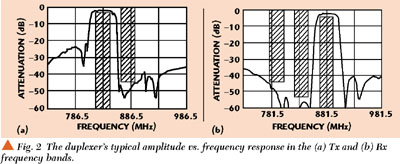A Breakthrough SAW Duplexer for Cellular Applications
Sawtek Inc.
Orlando, FL
As RF design engineers are tasked to integrate more radio functions into cellular handsets while migrating from single-mode to multi-mode/multi-band models, it's natural to conclude such a hybrid would increase in size, weight and cost. In contrast, the handset consumer demands smaller and thinner profile products with enhanced functionality. Through a decade of steadily falling prices, many consumers also expect newer, smaller phones to come with newer, smaller price tags. These diametrically opposed paths are pushed down to the RF component suppliers who are expected to resolve the conflict with next-generation solutions. These "wish list" specs have now become a reality with one of the world's smallest cellular RF duplexers.
Duplexers (providing a combination of filters separating transmit and receive signals for simultaneous transmission and reception in CDMA/TDMA/ AMPS phones) were previously too bulky and heavy to fit aggressive new low profile handset designs. This article demonstrates how it is possible to meet both the demands of designers and the expectations of consumers through the size, weight, performance and price of this new cellular RF duplexer.
SIZE AND WEIGHT
Ceramic duplexers were previously the only option for designers. Measuring approximately 20 mm by 10 mm by 4 mm, the devices were frequently the largest passive component on the board. The new duplexer is a petite 5 mm by 5 mm by 1mm (nominal), fully 82 percent smaller than first generation surface acoustic wave (SAW) duplexers and a whopping 97 percent smaller than the ceramic solution. Likewise, this new featherweight duplexer is 75 percent lighter than first-generation SAW duplexers, and a surprising 97 percent lighter than its ceramic counterpart. Figure 1 shows a comparison of the size of the new cellular RF duplexer (top unit) vs. a first-generation SAW duplexer and ceramic duplexer (bottom).

PERFORMANCE
The new miniature duplexer is one of the smallest cellular duplexers in the world, yet offers improved electrical performance compared to first-generation SAW devices while simultaneously meeting the high power handling requirements of CDMA/TDMA/AMPS architectures. Key typical characteristics include insertion loss of 2.1 dB in the transmit band and 3.1 dB in the receive band, and isolation of 65 dB over the 824 MHz to 849 MHz frequency range and 47 dB over 869 to 894 MHz. The device features return losses of 13 and 14.0 dB with respect to Tx/Rx bands, and receive and transmit rejections of 58 and 45 dB, respectively. Figure 2 shows the duplexer's typical amplitude response in the Tx and Rx frequency bands. The shaded areas indicate specification limits. Figure 3 shows its Tx/Rx isolation characteristics.


FASTER TIME-TO-MARKET
Initial SAW duplexers required multiple die. This approach resulted in devices requiring non-standard SAW manufacturing equipment and a custom package. The company's monolithic solution utilizes the latest in mainstream, automated SAW assembly equipment and packaging in line with all its other RF SAW filter products. These characteristics speed time-to-market and allow a competitively priced product while also delivering uniquely optimized performance in each Tx and Rx frequency band at a significant reduction in size and weight. Complete data sheets and delivery information may be obtained via E-mail at info@sawtek.com.
Sawtek Inc.,
Orlando, FL (407) 886-8860.
Circle No. 302
